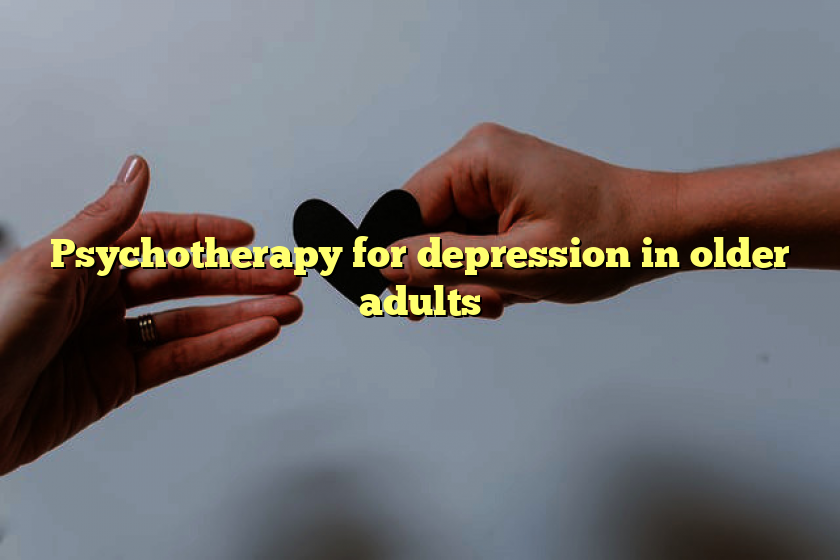As the US population ages, mental health professionals find their patients aging as well. Over the past 3 decades, there has been a substantial increase in the number of clinical trials that have looked at the effects of psychosocial interventions on late-life depression. The literature has been broadly supportive of psychotherapy as a first-line treatment for late-life depression (MDD in persons aged 65 and older).
Cognitive-behavioral therapy (CBT), problem-solving treatment (PST), and interpersonal therapy (IPT) have the strongest evidence base for treating patients with late-life depression.1 Although these therapies are helpful in making treatment decisions in general, there is little to inform mental health clinicians about the conditions under which one treatment may be better than another and how to accommodate age-related challenges for effective delivery of psychotherapy.
Research on the effectiveness of psychotherapy in late-life depression is relatively sparse, although there has been considerable growth in the database in the past 15 years. Most studies that are large enough to determine a stable effect of treatment have focused on ambulatory, middle- to high-income older adults. Only a handful of studies have looked at the effects of psychotherapy on older adults who are medically ill or disabled or who have mild cognitive complaints.
Not all psychotherapies have been studied; for instance, large clinical trials on psychodynamic therapy, behavioral activation, or mindfulness-based therapies do not exist. Research on other interventions, such as reminiscence therapy and supportive therapy, have only been explored as comparisons with other treatments, and although these therapies appear to have very positive effects on depression and function, they tend not to have as strong an effect as CBT, PST, and IPT do.2
CASE VIGNETTE
Mrs S, an older woman, was referred by her daughter for a differential diagnosis and treatment recommendation. The patient had been forgetting important appointments and was beginning to isolate herself from her family. The patient’s husband had died 5 months earlier, and during her interview, she indicated that although she missed her husband, she had already processed her grief.
In an interview with her daughter, it was discovered that the patient had lost her son to suicide 15 years earlier, and that after the funeral, the patient’s husband had told her that she was not to talk about her son ever again. She had that day to mourn him, but after that he did not want to see or hear her cry. The patient complied dutifully.
Treating older adults
CBT was compared with expressive psychotherapy in older caregivers for dementia patients. Long-term caregivers responded better to CBT, while those who were newer to caregiving responded better to expres-sive psychotherapy.3 Theoretically, recent caregivers were focused on mourning the loss of their spouse’s or parents’ cognitive skills, whereas longer-term caregivers had already processed this loss and instead were focused on practical issues related to caregiving.
Clearly, there were several interpersonal and grief-related issues driving this patient’s depression. IPT was recommended, because of its success in treating complicated grief.
Studies of the effects of gender and advanced age found that these factors do not influence treatment effects. With healthy older adults, clinicians can use their judgment and patient preferences to select among 3 very effective interventions.
What is already known about treating depression in older adults?
? Both psychotherapy and antidepressant medications can successfully treat depression in late life. The most effective behavioral interventions are cognitive-behavioral therapy, interpersonal therapy, and problem-solving treatment.
What new information does this article provide?
? This article provides a practical overview of the available evidence-based treatment and discusses circumstances in which certain interventions may be preferred over others.
What are the implications for psychiatric practice?
? Behavioral treatment of late-life depression is effective and may be tailored to the individual patient.
Older adults with medical illnesses
There have been few psychotherapy trials with older adults with specific medical illnesses. CBT is an effective intervention for managing both depression and anxiety symptoms in patients with chronic obstructive pulmonary disease.4 However, evidence to support the use of CBT for depression in patients with cardiovascular disease and heart failure is insufficient.5 Trials are under way to study the effects of CBT in patients with type 2 diabetes mellitus.6
PST has been studied broadly as a depression intervention in older medical patients and has been found to be effective; however, PST studies for specific disease entities have yet to be conducted.7-9 Research findings for IPT in medically ill older adults are similar to those for PST; as an intervention in primary care medicine, IPT is an acceptable and effective depression treatment.10 However, there are no large-scale studies of IPT for specific medical illnesses.
Clinicians are faced with having to decide among 3 effective treatments with very little information about their impact on depression in patients with specific medical conditions. As of this writing, PST and IPT are good choices for general medical patients; they can be easily delivered in a primary care setting.
The traditional therapeutic time frame can be a barrier to the delivery of psychotherapy in the medically ill. Weekly appointments and 50-minute sessions may be hard for many medically ill patients, particularly for those who may have numerous medical appointments, have days when they feel particularly fatigued and ill, and who need help getting to their appointments. PST and CBT are effective even if the interval between sessions is 2 weeks. If a clinician and patient agree that longer between-session intervals are appropriate, then it is helpful to provide the patient with support materials to use between sessions.
Enlisting family members to assist with therapeutic activities between sessions can also be helpful. If fatigue is an issue, psychotherapies geared toward shorter sessions (eg, PST) or in-home therapies (eg, self-guided CBT) may be appropriate.11 Patients with chronic pain may need to adjust positions during therapy; thus, frequent breaks during the session may be needed. Telephone therapy is another option for addressing pain concerns.
Cognitive complaints/impairment
Normal age-related changes in cognition do not usually interfere with psychotherapy.12 However, minor impairments may complicate treatment. There are few studies of psychotherapy for late-life depression in older adults with cognitive complaints, with the exception of older adults with mild to moderate executive dysfunction-a common cognitive complaint in most people with depression and a noted risk factor for poor response to antidepressants.1,12
Only PST has been rigorously studied and found to be effective in depressed older adults with mild executive dysfunction.13,14 There have been no large-scale studies of IPT for depression in older adults with mild memory complaints.15 CBT has been researched as an intervention for depression in older adults with moderate dementia, but the results have not been positive.16 A recent systematic review found that the most effective interventions for persons who have dementia and neuropsychiatric symptoms are behavioral interventions that include assessment of the causes of the symptoms and plans to reduce or prevent symptoms from occurring.17
The success of learning-based therapies-CBT and PST-is most affected by a patient’s memory impairment and cognitive slowing. To address problems associated with cognitive slowing when providing PST or CBT, present therapeutic material at a slower pace and over a longer period. Frequent demonstrations of the therapeutic technique with a generic example and regular in-session practice also help older patients learn new coping skills. By going slowly, you can gauge how well the patient understands the new skill.
TABLE



